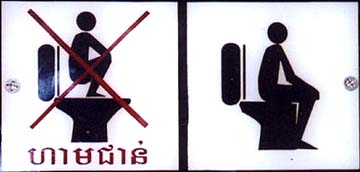What's that bridge, and which way are those trains going?

On Saturday, I was at my friend Dan's house in Astoria (Queens, for non-New Yorkers), acting in a short film he was shooting. He wanted the main characters of shot against the New York skyline for the opening credits, so we walked down to Astoria Park. I'd never been there before...it was quite pretty. The park runs along the East River, across from Randall's Island (or was that Ward's Island?), in the shadows of the Triboro Bridge and another bridge, one that Dan said was used by Amtrak trains. Standing there under the bridge, those assembled had several questions.
- What was this bridge called?
- How could it carry Amtrak trains? There's no Amtrak service on Long Island.
- Is that Randall's Island we're looking at, or Ward's Island?
Once I got back to a computer, I found out that the bridge is now called Hell Gate Bridge, named after Hell Gate, the passage it spans. According to Wikipedia, "Hell Gate" is a corruption of its original Dutch name, Hellegat (or "bright passage"). The entire East River was so named by the Dutch explorer Adriaen Block in 1614. The hellish Anglicization turned out to be appropriate: hundreds of ships had sunk in Hell Gate by 1876, when the U.S. Army Corps of Engineers used 50,000 lbs. of explosives to blow up the most treacherous rocks in the strait.
As for Randall's Island and Ward's Island, they are now connected by landfill. The body of water that used to separate them? Little Hell Gate.
Still no explanation, though, of what Amtrak trains were doing on Long Island. I finally had to look at maps and aerial photographs to figure out what was going on. (Pardon me if this obvious to you...I've never taken a train from New York to Boston. Only cars and Chinatown buses.) It turns out that when an Amtrak train leaves Penn Station, it goes under the East River through the East River Tunnels, just like Long Island Rail Road trains. Why? In 1901, the Pennsylvania Railroad, which then terminated in Jersey City, bought the Long Island Rail Road, which then also did not reach Manhattan. The Pennsylvania Railroad dug tunnels under the Hudson and East Rivers, built the then spectacular Pennsylvania Station, and their access to Manhattan was only rivalled by that of the New York, New Haven and Hartford Railroad, which terminated at Grand Central. (Portions of the latter are now Metro North and the Amtrak Northeast Corridor.)
The portion of the Amtrak route in Queens runs along the New York Connecting Railroad. According to Wikipedia:
So, if you see a train heading northwest, away from Queens, it's actually bound for the Northeast, across the viaducts of Randall's/Ward's Island and into the Bronx. As far as I can tell, it seems that that line meets up with the Metro North New Haven line, which goes up through Harlem and stays farther from the water than the Hell Gate Amtrak section, at around New Rochelle. I'm not sure whether Amtrak uses both sections or not, though apparently, Metro North trains may use the Hell Gate Bridge some time in the near future.Amtrak owns the line north of Sunnyside Junction, which forms part of the Northeast Corridor. South of this point, CSX is the owner.
The line begins at the Hell Gate Bridge over the East River. This is a massive span, a main span of 1,017 feet (310 m) and a total length of over 17,000 feet (5.2 km). Continuing south the line is on a high-level elevated viaduct, over Astoria and Interstate 278 (Grand Central Parkway). The line then is on an embankment and Sunnyside Junction, where Amtrak's Northeast Corridor line branches off, is here. The line heads south and parallels Interstate 278 (Brooklyn Queens Expressway) for a distance. This portion of the line was completely rebuilt in 2002. Now in the section of Elmhurst, the NYCR passes under several streets in a cut. An arched concrete viaduct over Queens Boulevard is followed by street overpasses under cut and overpasses over streets as well in Maspeth. After crossing under the Long Island Expressway (Interstate 495) and passing a few cemeteries, the line reach Fresh Pond Yard. This is the main facility for shipping freight by rail in and out of New York City and Long Island.
By the way, if you enjoy the Hell Gate Bridge (and its dark red color, from its paint job in 1996), you will be happy to know that it may be around for a while. According to the February 2005 issue of Discover magazine, if humans disappeared, Hell Gate would be the last New York bridge to collapse: they estimate it would stand for 1,000 years.
Further reading
The History of Amtrak, or, Can you believe America actually has a nationalized industry of any kind?
A map of Queens neighborhoods
Labels: bridges, geography, New York City, Queens, trains

